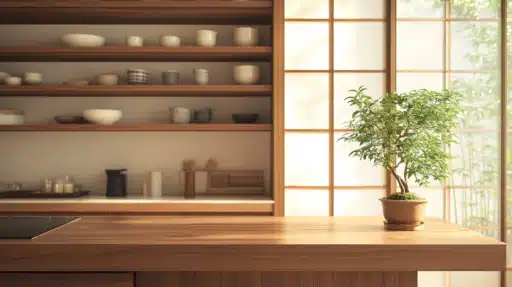Japanese kitchens are known for their smart design and focus on simplicity.
If you want to update your cooking space, taking ideas from Japanese kitchens can be a great choice.
These kitchens often make the most of small spaces, use natural materials, and keep things tidy.
This blog will examine 13 of the best Japanese kitchen ideas for your home.
From clever storage solutions to calming color schemes, these ideas can help create a kitchen that’s both useful and nice to look at.
You’ll find plenty of options here to completely change your kitchen or add a few Japanese-inspired touches.
Let’s explore these ideas to help make your kitchen more organized and peaceful.
Best Japanese Kitchen Ideas
1. Minimalist Design

A minimalist kitchen design embraces simplicity by removing unnecessary clutter.
This approach uses streamlined cabinetry and open shelving, creating an open and airy atmosphere.
It prioritizes function over decoration, making the kitchen feel calm and organized.
The minimalism extends to color schemes, with neutral tones like white, light gray, or softwood finishes being ideal.
This clean look not only makes the space visually appealing but also helps maintain the focus on the kitchen’s purpose—cooking and family gatherings.
2. Shoji Screens

Shoji screens offer a perfect blend of traditional aesthetics and practicality.
These sliding panels, crafted with wooden frames and translucent paper, gently divide spaces such as the kitchen and dining area.
Their soft, diffused light creates a warm, inviting atmosphere while adding an element of privacy.
Shoji screens allow for a seamless flow between different rooms, preserving the open feel of the space.
This delicate feature brings a touch of tradition into modern kitchens without overpowering the overall design.
3. Dark Wood Accents

Incorporating dark wood accents into your kitchen adds a rich contrast that balances lighter elements in the space.
Cabinets, flooring, or shelves made from dark wood provide a sense of depth and elegance.
The natural texture and deep tones of the wood offer warmth, complementing the minimalistic design often seen in Japanese kitchens.
Dark wood accents blend well with various design elements, adding both visual interest and harmony to the overall atmosphere.
4. Natural Wood Countertops

Natural wood countertops offer a timeless, warm feel to any kitchen.
Their unvarnished, raw appearance brings the beauty of nature into the space, enhancing the overall sense of calm.
The subtle grain and texture of the wood contrast nicely with modern stainless steel appliances or ceramic elements, creating an inviting and balanced environment.
Wood countertops are not only durable but also help in maintaining the organic, simple feel of a traditional Japanese kitchen.
5. Japanese Ceramic Tiles

Hand-painted Japanese ceramic tiles add a personal and artistic touch to your kitchen, particularly when used as a backsplash.
These tiles often feature delicate designs or nature-inspired motifs, such as cherry blossoms or flowing water, providing a subtle yet striking focal point.
The craftsmanship behind each tile enhances the overall aesthetic of the kitchen, adding texture and color without overwhelming the space.
This thoughtful design element offers a way to blend functionality with beauty.
6. Sliding Cabinet Doors

Sliding cabinet doors are a functional and space-saving feature perfect for compact kitchens. Instead of swinging outward, these doors slide open, allowing easier access in tight spaces.
They are also an elegant way to maintain a streamlined look, as their simple operation reflects the minimalist principles of Japanese design.
Sliding doors can be made from materials such as wood, frosted glass, or bamboo, and they provide a clean, efficient solution for maximizing storage while keeping the kitchen neat.
7. Bonsai Corner

A dedicated bonsai corner in the kitchen brings a touch of nature and artistry indoors.
These miniature trees, known for their intricate shapes and delicate beauty, add a serene, organic element to the kitchen.
Whether placed on a counter, windowsill, or shelf, a bonsai tree not only enhances the aesthetic of the space but also connects you with nature, encouraging mindfulness.
This simple addition can help create a peaceful, balanced atmosphere within the kitchen.
8. Engawa-Inspired Balcony

An Engawa-inspired balcony draws from the traditional Japanese concept of an open-air corridor.
If space allows, creating a small balcony or deck adjacent to the kitchen extends the indoor living space.
This area can be used for light dining, tea, or quiet relaxation.
The design evokes a sense of harmony with nature by incorporating wooden flooring and simple seating.
The Engawa-inspired balcony encourages natural light and fresh air to flow into the kitchen, enhancing its openness and serenity.
9. Rice Paper Lighting

Rice paper lighting adds a warm and soft glow to the kitchen, reflecting the simplicity and elegance of Japanese design.
These lights, often lanterns or pendant lamps, create a diffused light that brings a cozy, relaxed atmosphere to the space.
The delicate texture of the rice paper pairs well with other natural materials like wood or stone, maintaining the kitchen’s harmony and balance.
This type of lighting offers an understated yet beautiful way to enhance the kitchen’s ambiance.
10. Wood-Lined Ceiling

A wood-lined ceiling adds warmth and texture to the kitchen, creating a cozy, intimate environment.
Using wooden beams or slats overhead can give the space a traditional Japanese feel, enhancing the sense of enclosure and comfort.
The wood’s natural grain contrasts beautifully with minimalist cabinets or stone surfaces, fostering a balanced, harmonious atmosphere.
A wood-lined ceiling can also make the kitchen feel more cohesive, tying together different natural elements throughout the space.
11. Teppanyaki Countertop

A built-in teppanyaki grill offers an interactive cooking experience right on the kitchen countertop.
This feature is ideal for preparing meals while engaging with family and guests.
Teppanyaki cooking involves grilling directly on a flat, heated surface, making it perfect for communal dining.
The integrated design saves space while offering a unique cooking style that blends seamlessly with modern kitchen layouts.
This feature encourages a social, participatory approach to meals, reflecting the communal values present in Japanese dining.
12. Furoshiki Storage

Furoshiki, traditional Japanese wrapping cloths, bring a touch of cultural authenticity to kitchen storage.
These multi-functional cloths can be used to wrap and store items like utensils, groceries, or dry goods, offering a practical and visually appealing solution.
Furoshiki are available in various sizes and designs, allowing you to incorporate personal style into your kitchen.
This eco-friendly storage option combines beauty with function, making it a thoughtful and sustainable addition to any kitchen space.
13. Custom Storage for Japanese Tools

Creating dedicated storage for specific Japanese cooking tools, such as a tamagoyaki pan or rice paddle, helps maintain an organized and culturally aligned kitchen.
These tools often have unique shapes and uses, so custom storage ensures they are easily accessible without adding clutter.
Well-designed storage solutions, like built-in slots or hanging racks, keep these tools neatly arranged while preserving the minimalist aesthetic.
This attention to detail enhances the kitchen’s practicality and cultural significance.
Conclusion
As we wrap up our tour of Japanese kitchen ideas, it’s clear that these designs offer more than just good looks.
They bring together smart use of space, easy cleaning, and a calm feeling that can make cooking more enjoyable.
Whether you add a few touches like a bamboo mat or go all-in with a minimalist makeover, these ideas can help create a kitchen that works well and feels peaceful.
Remember, keeping things simple and focusing on your needs is key. Why not start small?
Try clearing your counters or adding some natural elements to your kitchen.
You might be surprised at how these small changes can make a big difference in how you feel when cooking or spending time in your kitchen.
Ready to give your kitchen a Japanese-inspired update?








